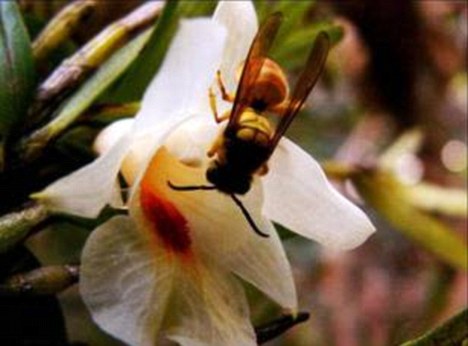Jerry Coyne is one of the leading evolutionary biologists in the world who quite literally wrote the book on speciation. Like all evolutionary biologists with a high profile, he also attracts his fair share of cranks and crackpots. In October 2013, he attracted the attention of yet another evolution denialist, who goes by the nom de plume Asyncritus. Coyne's destruction of Asyncritus is a work of art:
A commenter named “Asyncritus” tried to leave an anti-evolution comment on a post I wrote about how some orchids in China have evolved a scent resembling the alarm pheromone of the honeybees that are the wasps’ prey.
The flower’s scent apparently attracts the wasps looking for prey, and those wasps pollinate the orchids. This clever adaptation, a form of “olfactory mimicry” to help the flowers reproduce, was published in Current Biology. The orchid does not show morphological mimicry like some other “bee orchids, whose flowers have evolved to resemble bees, luring male bees who, in trying to copulate with the mimetic flowers, pollinate them
Here’s a picture of that orchid, Dendrobium sinese, in the Daily Fail (it has not escaped my notice that perhaps the colors of the flower, which look vaguely beelike, might help attract the wasp):
But on to the creationist. Sadly, Asyncritus, apparently knowing very little about evolution, tried to weigh in with this comment:
If this lot doesn’t persuade any unbiassed observer that evolution is a complete nonsense, then I don’t know what will.
How can a plant possibly figure out that this compound is an alarm pheromone secreted by wasps?
And that if it does so figure that out, how does it know that there are such things as wasps?
And that they will come, pick up the pollen and take it to another flower to pollinate it?
Isn’t it obvious that this didn’t evolve ‘by small steps’ and that it is perfectly designed to do the job it does so well?
Get smart, guys.
Asyncritus is the one who should get smart. Plants—or anything
else—don’t figure out how to evolve. (Plants, for one thing, can’t
figure anything out!) If the ancestral orchid had genetic
variation that made its scent resemble in some degree the bee pheromone,
then it would get pollinated by wasps more often. Such variants would
leave more of their genes, and the adaptation would spread. The plant
doesn’t need to know that there are pollinating wasps around, either.
All that has to happen is that there be mutations in flower odor that
attract the wasps. No evolving species has to consciously “know” what it
has to do to adapt to the environment.
This misconception—that plants and animals have to figure out how to evolve by sussing out the environment—is surprisingly common, and Asyncritus’s rancor is poorly aimed. He or she is the one who needs to bone up on evolution.
As for the step-by-step evolution of the plant “pheromone,” that remains to be studied. We know what the compound is, for it’s been extracted, structurally identified, and shown to have not only be chemically identical to the alarm pheromone of bees, but also to attract the pollinating wasps. (The compound, by the way, is (Z)-11-eicosen-1-ol.) If this compound evolved from an ancestral compound (presumably via the modification of enzymes that change the structure of organic molecules), then we should be able to find precursor compounds that have other functions in this species or its relatives, and be able to identify the pathway that synthesizes the new attractant. This need not have happened via a gradual, many step-process, for sometimes single mutations alone can have this effect. (One “big” mutation, for instance, is known to have radically altered flower color in the species Mimulus guttatus versus M. cardinalis.)
I wrote the senior author of the Current Biology paper asking if we know how the “plant pheromone” is made, or what likely precursors there were, but he said that nobody has studied that question. So there’s an evolutionary prediction that can be tested. In the meantime, perhaps Asyncritus can use this “teachable moment” (I hate that term) to bone up on the theory he/she doesn’t understand.
Ouch. That is going to leave a mark. Of course, it is highly likely that Asyncritus regards himself as wiser and smarter than Coyne. If that be the case, Asyncritus could always marshal his thoughts, write a paper, submit it for publication in the peer-reviwed journals, and aim to prove his point to the satisfaction of the scientific community. Or he could continue to peddle his one-trick pony to discussion forums where he gets called out for intellectual dishonesty. Whether Asyncritus likes it or not, the only way he is ever going to be taken seriously is to get an education in science, and aim to make his case to the satisfaction of the scientific community. As vertebrate paleontologist Per Ahlberg pointed out when debating a particularly clueless creationist on early tetrapod evolution:
OK, fine, if that's what you think, why don't you marshal your arguments into a paper and submit it to a scientific journal? I'm serious: the Intertubes is all very well for discussing ideas in a general way, but if you have a real scientific point to make you need to get it out in the form of a proper paper in a peer-reviewed journal. Otherwise it won't be taken seriously.
